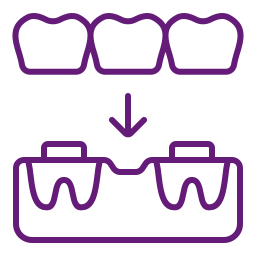Dental Filling / Teeth Filling
Introduction to Dental Filling / Teeth Filling
Dental filling / teeth filling is a common restorative procedure used to repair cavities, cracked, or worn-down teeth. It involves removing the decayed portion of the tooth and filling the area with a durable material to restore its shape, function, and strength. This treatment helps in preventing further decay and preserving the natural tooth structure. With advancements in dentistry, various types of fillings are available to suit different dental needs and preferences.

Talk to our Specialist
Benefits of Dental Filling / Teeth Filling
Getting a dental filling provides numerous advantages:
- Prevents Further Decay: A filling seals the cavity, preventing bacteria from spreading and causing more damage.
- Restores Tooth Function: Fillings help in chewing, biting, and maintaining proper oral function.
- Enhances Aesthetic Appearance: Tooth-colored fillings match natural teeth, improving the smile’s appearance.
- Long-Lasting Solution: Modern dental fillings are highly durable and can last for years with proper care.
- Minimally Invasive: The procedure preserves the natural tooth while repairing the damaged area.
Procedure of Dental Filling / Teeth Filling
The dental filling process is straightforward and typically completed in a single visit:
- Examination & Diagnosis: The dentist examines the affected tooth and may take an X-ray to assess the extent of decay.
- Anesthesia (If Needed): A local anesthetic is administered to numb the area for a painless procedure.
- Removal of Decay: The decayed portion of the tooth is carefully removed using dental instruments.
- Cleaning & Disinfection: The cavity is cleaned and disinfected to prevent bacterial infection.
- Filling Placement: The chosen filling material is applied in layers and hardened using a special light (for composite fillings).
- Shaping & Polishing: The dentist shapes the filling to match the natural tooth and polishes it for a smooth finish.
Types of Dental Filling / Teeth Filling
There are several types of dental fillings, each with unique properties and advantages:
- Amalgam Fillings: Made from a mixture of metals like silver, mercury, tin, and copper, these fillings are strong and durable, making them ideal for back teeth.
- Composite Fillings: A tooth-colored resin material that blends seamlessly with natural teeth, commonly used for front teeth or visible areas.
- Ceramic Fillings: Made from porcelain, these fillings are aesthetically pleasing and highly resistant to staining.
- Glass Ionomer Fillings: These fillings release fluoride, helping to prevent further tooth decay, and are often used for children’s teeth.
- Gold Fillings: Durable and long-lasting, but expensive, gold fillings are less common but highly effective.
Frequently Asked Questions
The lifespan of a filling depends on the material used and oral hygiene. Composite fillings last around 5-10 years, while amalgam and gold fillings can last 15+ years.
No, the procedure is painless as local anesthesia is used. Mild sensitivity may occur for a few days but subsides quickly.
Yes, fillings can wear out or fall out due to chewing pressure, decay, or poor maintenance. Regular dental check-ups help in detecting any issues early.
Maintain good oral hygiene by brushing, flossing, and avoiding excessive sugary foods. Regular dental visits help in monitoring the filling’s condition.
Dental filling / teeth filling is a simple yet essential procedure to restore and protect damaged teeth. Choosing the right filling material and maintaining proper oral care ensures long-term dental health. If you have a cavity or need a filling replacement, consult your dentist for the best solution.









